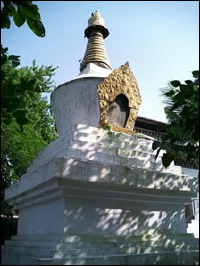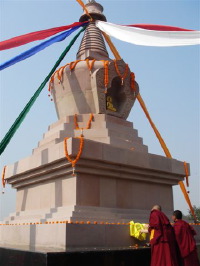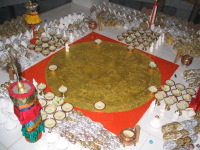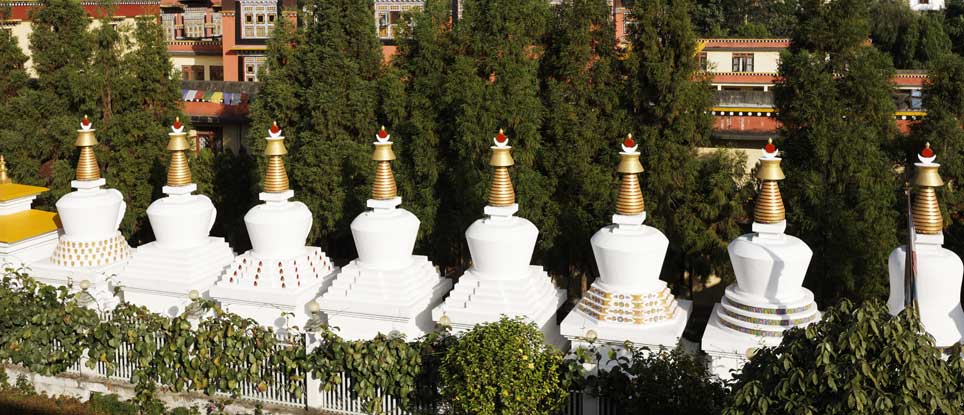Stupas for Peace
 A stupa is an architectural rendering of enlightened mind and symbolizes the different qualities of Buddhahood. Its shape represents the Buddha crowned and seated in meditation posture on a lion throne. The Tibetan for stupa is chorten (support for offerings). Every part of a stupa has specific significance and within it are scriptures and relics in defined positions, each equally alive with symbolic meaning.
A stupa is an architectural rendering of enlightened mind and symbolizes the different qualities of Buddhahood. Its shape represents the Buddha crowned and seated in meditation posture on a lion throne. The Tibetan for stupa is chorten (support for offerings). Every part of a stupa has specific significance and within it are scriptures and relics in defined positions, each equally alive with symbolic meaning.
In many Buddhist traditions, stupas are a place of pilgrimage and provide support for the practice of prostrations, offerings and circumambulations. They contain precious relics and scriptures and, especially when they are properly placed in important geographical points, have intrinsic power and invoke peace. A stupa is consecrated, not as a structure, but as a living enlightened presence, and therefore brings blessings not only to its location, but also to the world.
Dilgo Khyentse Rinpoche was a great luminary of Tibetan Buddhism in this  century. One of his principle teachers, Dzongsar Khyentse Chokyi Lodro (1893-1959), prophesied that to encourage and spread world peace, Khyentse Rinpoche should build a stupa in each of the eight sacred sites connected with the major events of Buddha Sakyamuni’s life.
century. One of his principle teachers, Dzongsar Khyentse Chokyi Lodro (1893-1959), prophesied that to encourage and spread world peace, Khyentse Rinpoche should build a stupa in each of the eight sacred sites connected with the major events of Buddha Sakyamuni’s life.
As a symbol of his wish to fulfill his teacher’s prophecy, Dilgo Khyentse Rinpoche built small replicas of these stupas at Shechen Tennyi Dargyeling Monastery in Nepal.
As he wrote, “Within the stupa, the blessings of the teacher remain unchanging. The Buddha said whoever sees a stupa will be liberated by the sight of it, feels the breeze near it will be liberated by its touch, and hears the tinkling of the small bells around it, will be liberated by the sound. Having seen a stupa, by reflecting on one’s experience of it, one is liberated by recollection. May these stupas become a supreme object of offering, liberating whoever sees them, touches them, hears of them, or remembers them.”
Before his passing in 1991, Dilgo Khyentse Rinpoche was able to only build and consecrate one of the eight, the Enlightenment Stupa, in Bodhgaya, India. Shechen Rabjam Rinpoche, Khyentse Rinpoche’s grandson and dharma heir, has fulfilled his vision by building the remaining seven. All eight stupas were built and consecrated in 2010, the hundredth anniversary of the birth of Dilgo Khyentse Rinpoche. Another larger stupa built adjacent to Shechen Monastery in Bodhgaya to commemorate Dilgo Khyentse Rinpoche.
Each of the eight Stupas are unique in construction and location:
- The Lotus Blossom Stupa at Lumbini, Nepal where the Buddha was born in the year 563 BC.
- The Enlightenment Stupa at Bodhgaya, India where the Buddha, then thirty-five years old, attained Enlightenment under the Bodhi Tree.
- The Stupa Of Turning The Wheel Of Dharma at Varanasi, India where the Buddha taught for the first time.
- The Stupa Of The Descent From a Heavenly Realm at Shankasya, India where the Buddha descended from a heavenly realm to repay his mother’s kindness.
- The Great Miracle Stupa at Sravasti, India where, at the age of fifty, the Buddha displayed inconceivable miracles. He also spent thirty summer retreats there.
- The Stupa Of Reuniting The Sangha at Rajagriha, India where the Buddha reunited the Sangha, which had been divided by Devadatta.
- The All-Victorious Stupa at Vaishali, India where the Buddha proclaimed that he would leave this world to pass into Nirvana but, at the supplication of a lay devotee, he extended his life for three more months.
- The Parinirvana Stupa at Kushinagar, India where, at eighty-one, he passed away.
The construction of these stupas is a spiritual task dedicated to peace in the world. All of the newly built stupas are made of hand-placed stone blocks with no concrete used on the outside. Stone carvings adorn the bumpa vase in the center. Tulku Rigzin Pema, a specialist in stupas, and the Shechen monks carefully prepared the many spiritual materials that are needed to fill them.
 Each of the stupas house: two mandalas engraved on steel; highly detailed banners, offering bowls, lamps, and conch shells (all made by the Tsering Art School); eighteen auspicious vases filled with statues of the relevant deities along with precious ingredients; 800 tsa tsas (small porcelain images) and zungs (millions of mantras inscribed on rolled paper anointed with saffron and precious herbs). Each of the stupas has a sokshing (life tree) in the center with gold-lettered mantras from top to bottom. The stupas have all been consecrated by Khyentse Yangsi Rinpoche in 2010.
Each of the stupas house: two mandalas engraved on steel; highly detailed banners, offering bowls, lamps, and conch shells (all made by the Tsering Art School); eighteen auspicious vases filled with statues of the relevant deities along with precious ingredients; 800 tsa tsas (small porcelain images) and zungs (millions of mantras inscribed on rolled paper anointed with saffron and precious herbs). Each of the stupas has a sokshing (life tree) in the center with gold-lettered mantras from top to bottom. The stupas have all been consecrated by Khyentse Yangsi Rinpoche in 2010.
The presence of a stupa contributes to the welfare and happiness of all beings, creates auspicious circumstances and subjugates negative forces. Making offerings to help build one brings boundless benefits, for many lives to come, for one’s self and others.
Funds to maintain the stupas and give offerings a the locations are welcome. Please go to our donate page.

